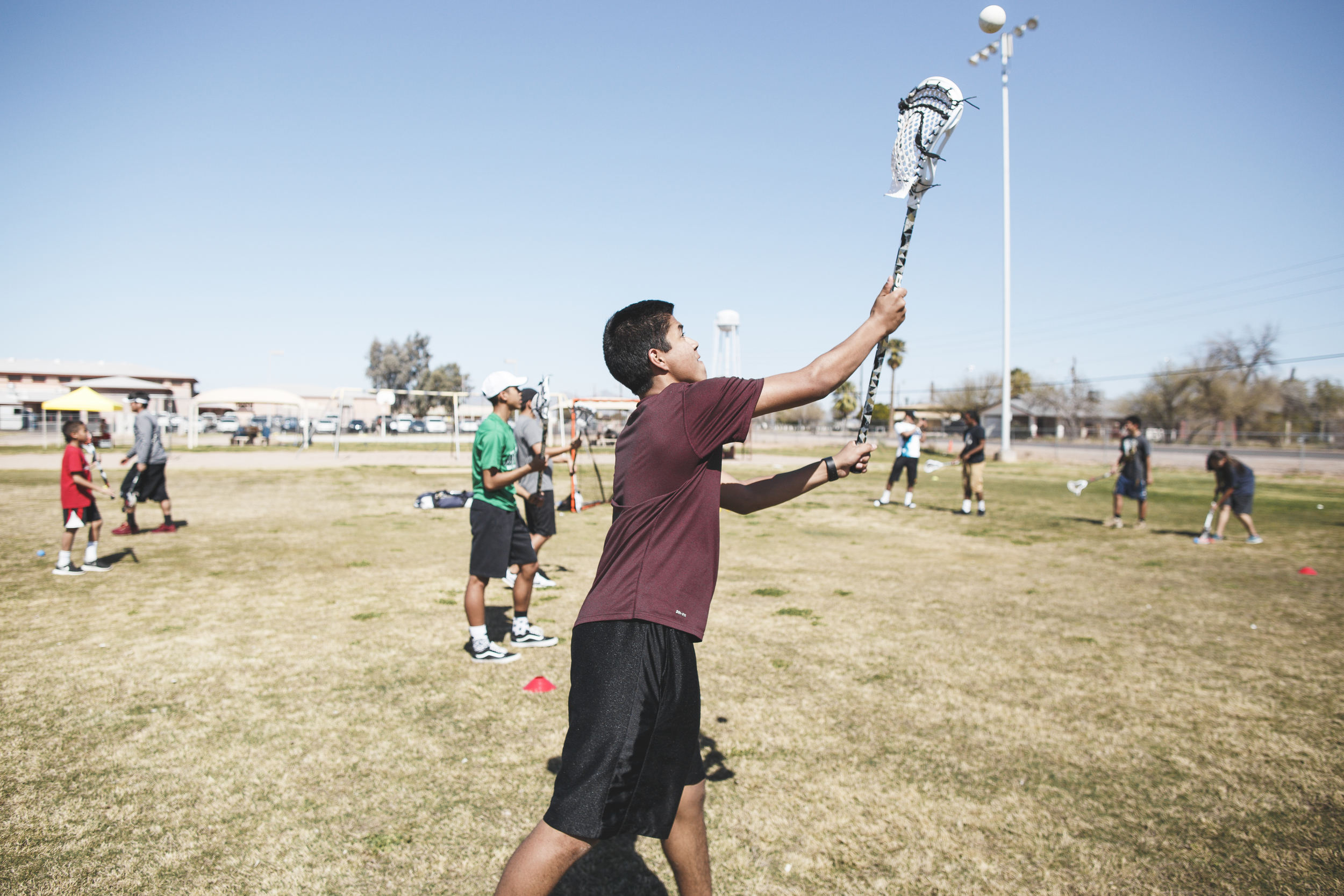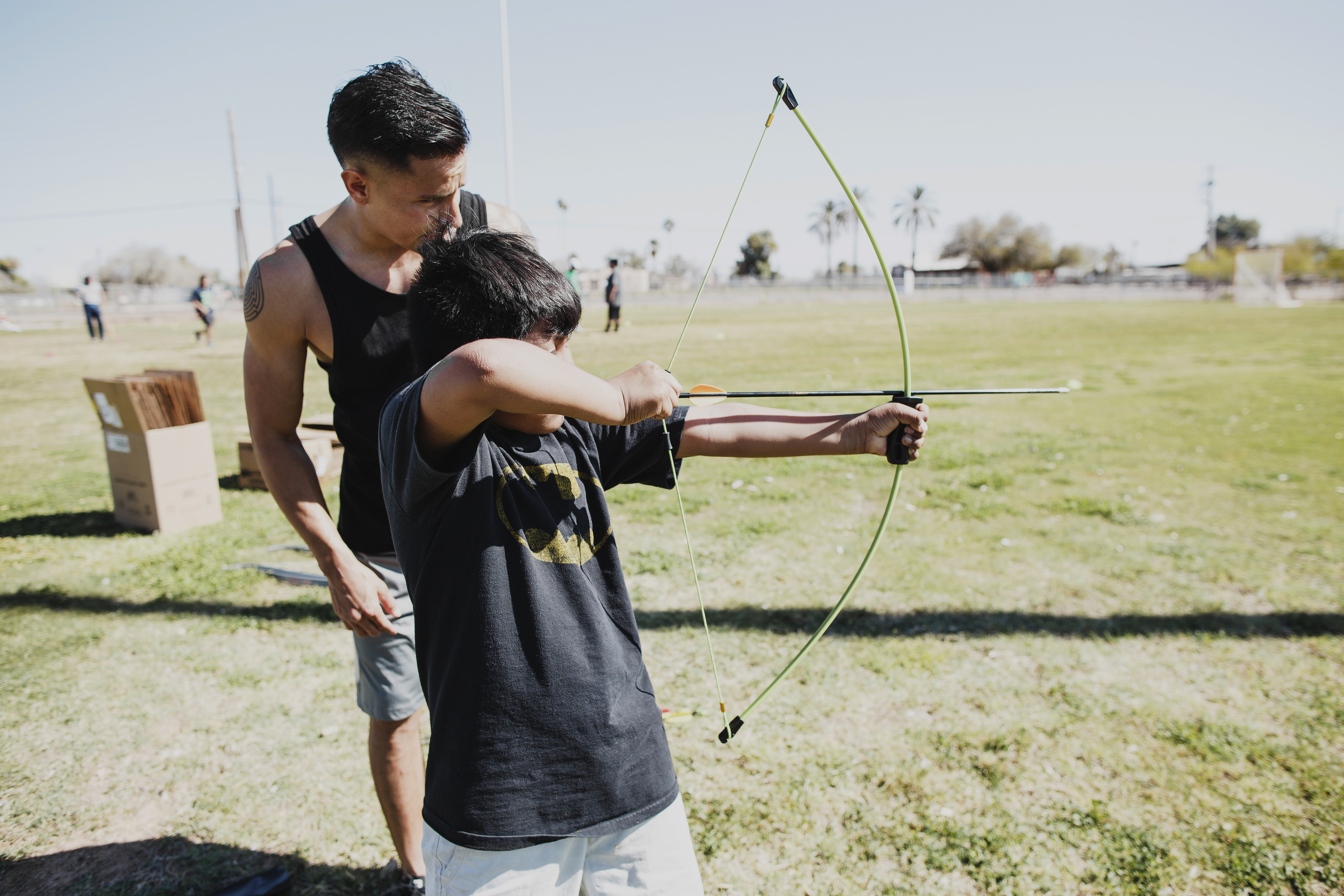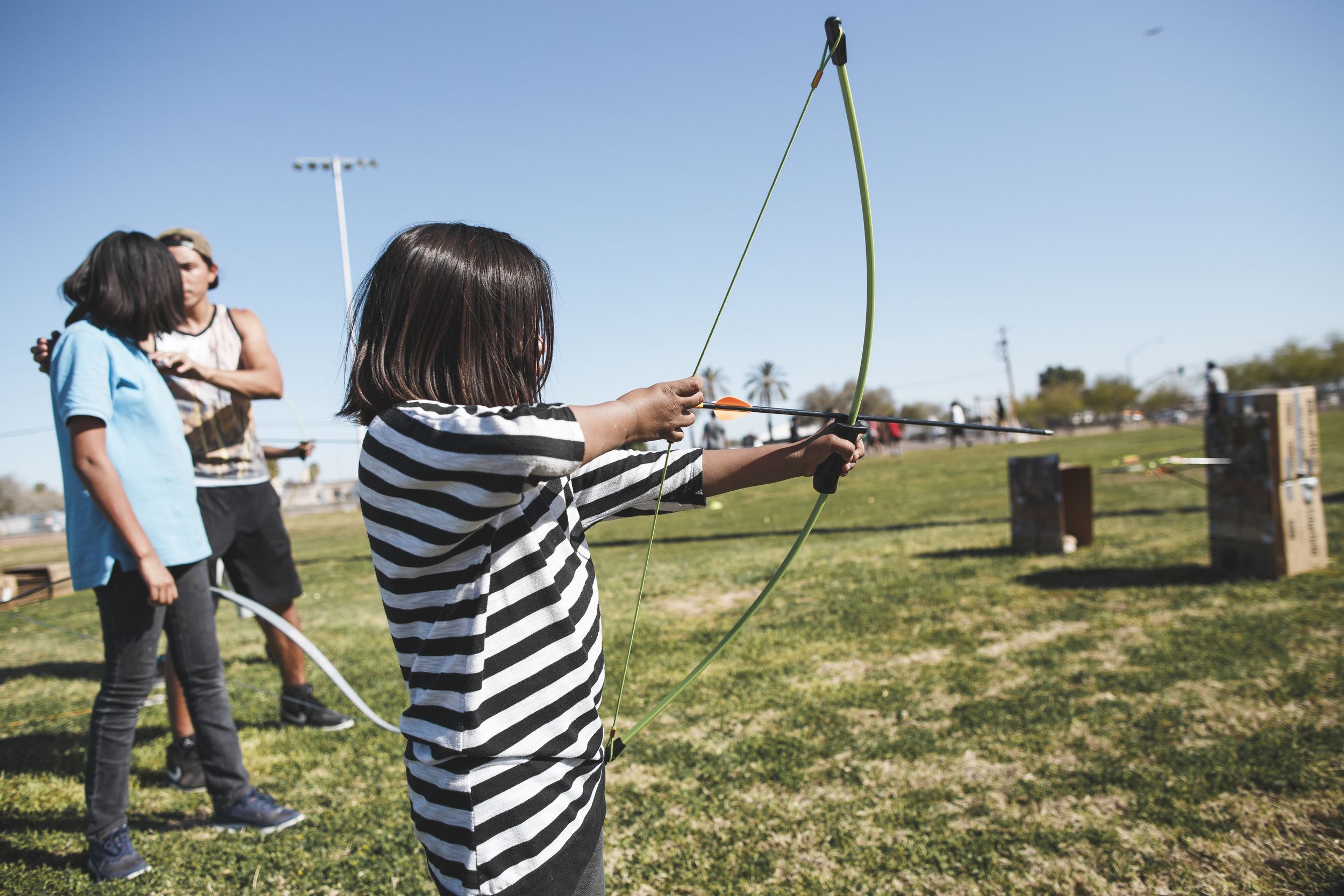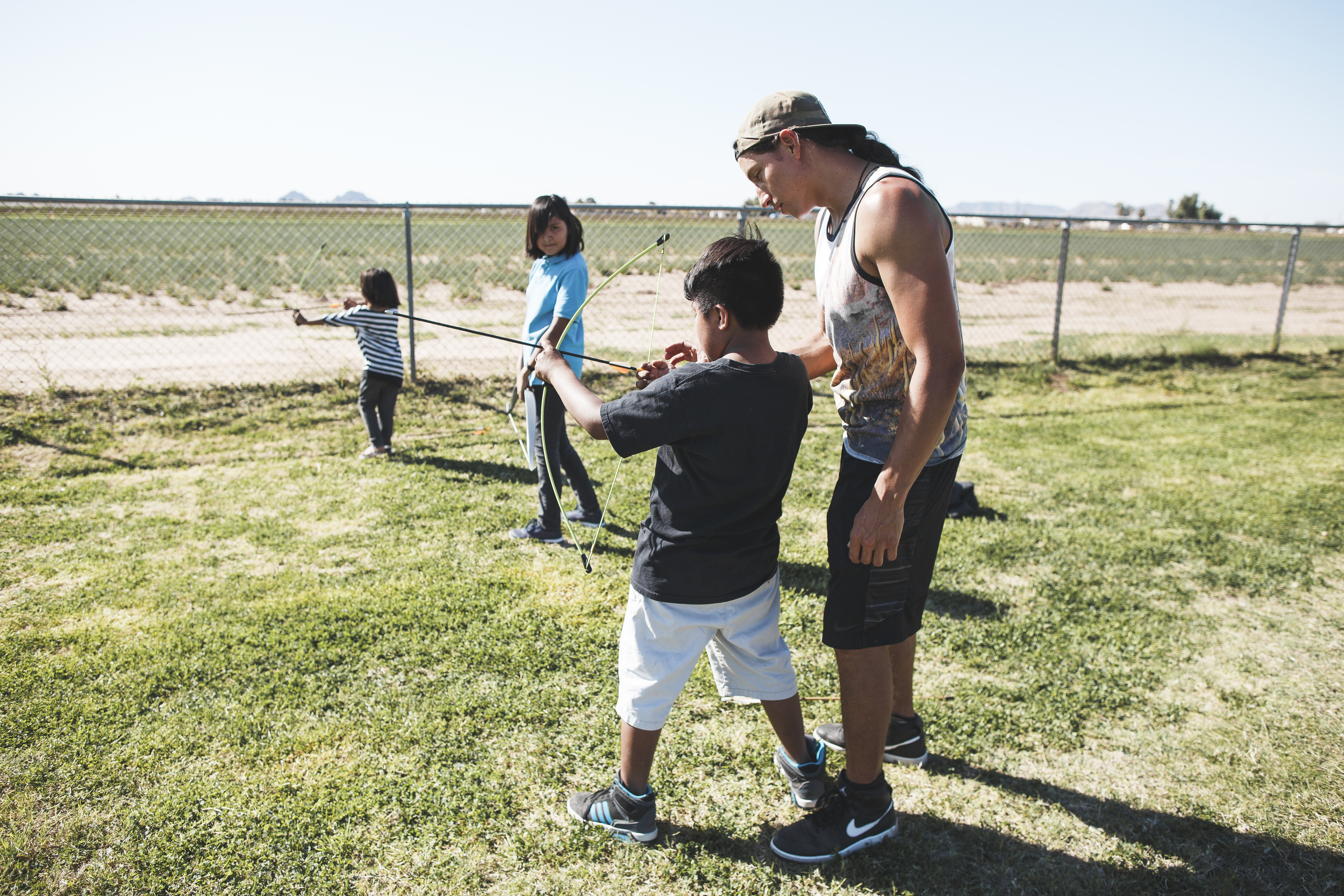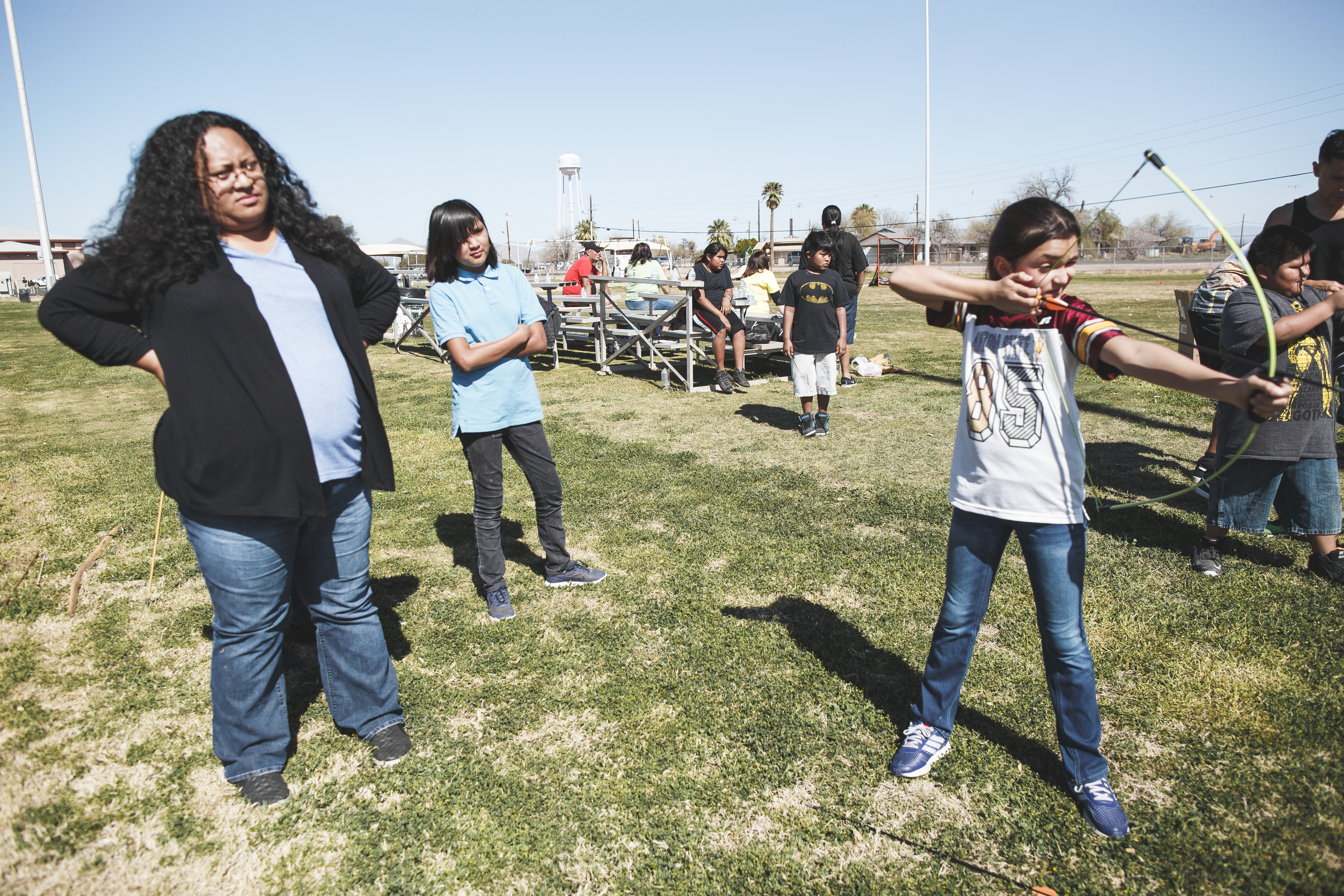Intertribal Games Gathering for Native Youth at Salt River
Last weekend, the Phoenix Indian Center in collaboration with the Native Wellness Institute hosted a fun day of intertribal games for youth at the Salt River Pima Maricopa Recreation Fields.
The day began with a warm-up of light exercises and dynamic stretching led by Thosh Collins (Akimel O'Odham) and an introduction by coordinator Robert Johnston (Muskogee Creek/Choctaw).
The kids then had the opportunity to try out the Creator's Game (LaCrosse) with a seasoned Navajo instructor who once played college LaCrosse for Princeton. Even though only one of the participants had ever played the game before, everybody enjoyed it and picked up on the game very quickly.
Set up next to the LaCrosse field with targets and a handful of small bows, the kids also had an opportunity to learn archery and basic bow skills from an avid local bow hunter, Amson Collins (Akimel O'Odham) with assistance from Thosh. They loved testing out the bow and learning some of its history and cultural significance. It was very exciting to see their eyes light up with every hit of the target. Shooting the bow and arrow requires hand-eye coordination skills, attention to detail, lessons in safety, patience, and practice. Learning this skill has the ability to initiate a sense of empowerment and pride in the child who is participating. The kids (some as young as 4 years old!) did an excellent job and showed their ability to connect with this longstanding athletic tradition of the people.
Overall, it was a successful day of learning and sharing new athletic skills, and the kids and instructors alike had a great time collaborating on the event. The intertribal games for native youth will persist once a month, for the next 3 months. For more information, contact them at 602-246-6768 or email rcooley@phxindcenter.org
Organic 101
There is a lot of confusion surrounding the topic of “organic” food. Understanding what “organic” (and other terms associated with natural foods) really means will help you to better choose the safest and healthiest foods for you and your family. It is a complicated topic which would require research into many tangential details to fully understand, but we’ll break down the most important points to alleviate some of this confusion.
There is a lot of confusion surrounding the topic of “organic” food. Understanding what “organic” (and other terms associated with natural foods) really means will help you to better choose the safest and healthiest foods for you and your family. It is a complicated topic which would require research into many tangential details to fully understand, but we’ll break down the most important points to alleviate some of this confusion.
If you take the time to learn the facts in this comprehensive guide, you will be empowering yourself to make educated decisions about food consumption. You have a right to know why so many people consider the higher cost of organic to be worth the money, and to decide for yourself whether it’s worth it for you.
What is organic?
The definition of and regulations that accompany the term “organic” vary from country to country, so if you need to know if your food is organic, the first thing you have to do is check is where the food was grown and traded. The United States and Canada follow very similar standards for organic food, so if the food that you are purchasing is USDA (United States Department of Agriculture) or CFIA (Canadian Food Inspection Agency) Organic Certified, you can trust that “organic” will mean the following:
The producer or farmer must abide by a stringent set of government standards while growing and processing the food
No synthetic pesticides, chemical fertilizers, artificial coloring, artificial flavor, or GMOs (genetically modified organisms) were used
Organic PRODUCE must be grown on soil that had no prohibited substances applied for three years prior to harvest
Organic MEAT requires that the animals have been living in conditions that accommodate their natural behaviors (such as the ability to graze or roam in a pasture), that the animals are fed 100% organic food, and that the animals are not injected with hormones or antibiotics
Organic PACKAGED PRODUCTS like chips or cookies must contain at least 70% certified organically produced ingredients, and the other 30%, if not entirely organic, must not contain GMOs
Is organic always healthier?
Many studies have been done to measure and compare the nutrient density of organic vs. inorganic food. The results vary so much from study to study and from food to food that in the end, the answer to this question remains broadly inconclusive.
Remember that nutrient density is contingent upon a lot of other factors - not just organic or inorganic. A lot of it has to do with whether the food has been cooked, whether the food has been frozen, how long the food has been on the shelf, how far the food has traveled, and many other things.
So, while the studies surrounding nutrient content remain inconclusive, it is still fair to argue that organic foods are, for the most part, healthier. Because while they’re not necessarily always going to be more nutrient dense, they are much more likely to be more safe.
We know that organic foods are almost always safer because we know that they have been produced without the use of “organophosphates,” which are the basis of most synthetic insecticides, herbicides, and nerve agents. The EPA (Environmental Protection Agency) has deemed “organophosphates” to be “highly, acutely toxic” substances to bees, insects, wildlife, and humans. The bottom line is this: people who eat organic fruits and vegetables ingest fewer pesticides. Pesticides are dangerous, so, organic foods are safer.
Why care about chemicals? The purpose for and dangers associated with synthetic chemicals: organophosphates, pesticides, hormones, insecticides, preservatives, GMOs, etc.
All of the above listed chemicals are things that farmers or food producers use on their crops or their livestock for purposes of saving money. Using these chemicals makes it easier to grow more, bigger, and longer-lasting produce, meat, and dairy. While they may be saving money and space, the risk associated with these chemicals is a serious one.
These chemicals have been known to cause a wide ranger of human health hazards, both short-term and long-term, including but not limited to: nausea, headaches, cancer, reproductive harm, endocrine disruption, nerve/skin/eye irritation, dizziness, fatigue, systemic poisoning, and more. Some of these health problems are minor, but others are potentially fatal.
Inorganic produce and meat is often cheaper and longer lasting, but the question remains: is it worth the health risk? Some argue that the cost of medical bills and lower quality of life that could come with consumption of inorganic food actually amounts to more money in the end. That’s up to you to decide.
Does organic taste better?
Many studies have been done comparing the taste of organic vs. inorganic products. As with nutrient density, these taste studies remain inconclusive because the results vary so widely. Remember that as with nutrient density, taste is often contingent upon the period of time between harvest and ingestion. If you pick something from your garden and eat it that day, the taste will be in its prime. If you purchase a product - organic or not - that has spent many days traveling hundreds or thousands of miles after being shipped internationally, it will inevitably lose some of its flavor. It is more likely that an organic food will be locally sourced than inorganic, but not all organic food is locally sourced.
Is organic more ethical and/or environmentally friendly?
In terms of produce, that depends on your perspective. Corporate food producers and large farmers argue that organic food is unethical and bad for the environment because it requires about twice as much land to produce the same amount of crop. However, others argue that organic farming is more ethical because it is being done without the use of harsh, synthetic chemicals that are dangerous for humans, animals, and the environment.
In terms of meat, it’s pretty much safe to say that organic is always more ethical. Again, some will argue that it is less environmentally friendly to produce organic meat because it requires so much more land to graze and produce the organic feed that the livestock are required to eat. However, it is a well known fact that the livelihood and dignity of animals in a mass-produced setting are largely disregarded. Many documentaries have been filmed and articles have been written about the inhumane treatment of animals in these settings. We recommend looking into that.
“The Dirty Dozen” - (High Risk Produce):
The EWG (Environmental Working Group) has studied and compiled a list of 12 types of produce that are most likely to contain pesticide residue. These are the least safe types of produce to purchase from a grocery store setting (when you don’t know exactly where they came from). If purchased, they must be washed very thoroughly. They are:
Apples
Celery
Cherry tomatoes
Cucumbers
Grapes
Nectarines
Peaches
Potatoes
Snap peas
Spinach
Strawberries
Sweet bell peppers
Also of note: hot peppers and kale/collard greens
“The Clean 15” - (Low Risk Produce):
The EWG has studied and compiled a list of 15 types of produce that are least likely to contain dangerous pesticide residue. As you’ll see, many of these fruits and vegetables are protected by naturally durable and thick outer surfaces. They are as follows:
Asparagus
Avocados
Cabbage
Cantaloupe
Cauliflower
Eggplant
Grapefruit
Kiwi
Mangoes
Onions
Papayas
Pineapples
Sweet Corn
Sweet Peas
Sweet Potatoes
Conclusion:
As with anything else, to be certified “organic” is almost as always a safer and more ethical bet. It’s fair to argue that it’s worth the money and the effort to buy organic. But even then, you can never really be sure just how carefully these things are being regulated. The only way that you can be absolutely certain that your food is naturally, lovingly, and safely produced is by growing/hunting/harvesting it yourself or by getting it from a local farmer/gardener/hunter who you know and trust.
In an ideal world, all of our food would be homegrown or traded. One day, we’ll get there. If not by choice, by necessity. The earth will only be able to sustain the current economy of corporate agriculture for so long. The rapid degradation of the environment is certainly of concern, and should be motivation for everybody to start learning how to produce their own food.
For now, we hope that this guide to organic foods will help you make the best possible choices.
The Creator's Game in the Twin Cities
Reclaiming Health, Culture and Tradition with Urban Native Youth by Sasha Houston Brown
Reclaiming Health, Culture and Tradition with Lacrosse by Sasha Brown
Over the past year, Indigenous youth and families have been coming together in south Minneapolis to revitalize the traditional game of lacrosse, the original game of North America.
For our people, lacrosse is much more than a sport. Lacrosse is an integral part of our history. It embodies our value systems, teachings, and Indigenous worldviews. Lacrosse has always been used to heal our people, to settle disputes, and to bring together our families and tribal nations.
My name is Sasha Houston Brown. I am Mdewakanton Dakota from the Santee Sioux Nation of Nebraska and I have the honor of working as a coach with Twin Cities Native Lacrosse. Twin Cities Native Lacrosse is dedicated to empowering Indigenous youth to reclaim their cultural, physical and spiritual strength as community leaders and athletes. We work to create safe environment where youth can build positive self-identification and self-esteem rooted in our Indigenous cultural values. In bringing back lacrosse, we are bringing back the practices our peoples used for millennia to promote optimal health.
The girls and boys I work with truly embody the vision of Well For Culture. Both on and off the field, they are learning to live by our ancestral teachings and re-indigenizing their physical, spiritual and emotional health. The Creator’s Game is in their blood, their ancestry, their genetic memory. You can see it from the very first time our youth pick up a stick.
When we step out on the field to play Thakâpsičapi (Dakota)/Baaga’adowewin (Ojibwemowin) our youth are playing for their ancestors, the sick, those in need of healing, and future generations. Even when competition gets fierce, we remind each other that we are relatives and that this game isn’t about winning, it’s a medicine game given to us by the Creator to ensure the well-being and survival of our peoples.
Image Gallery: Twin Cities Native Lacrosse


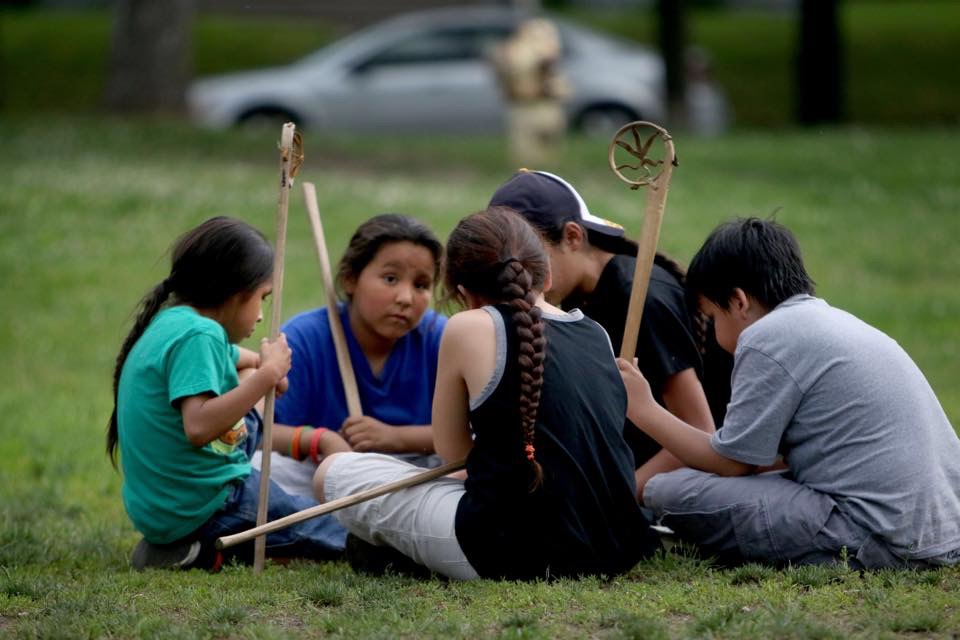

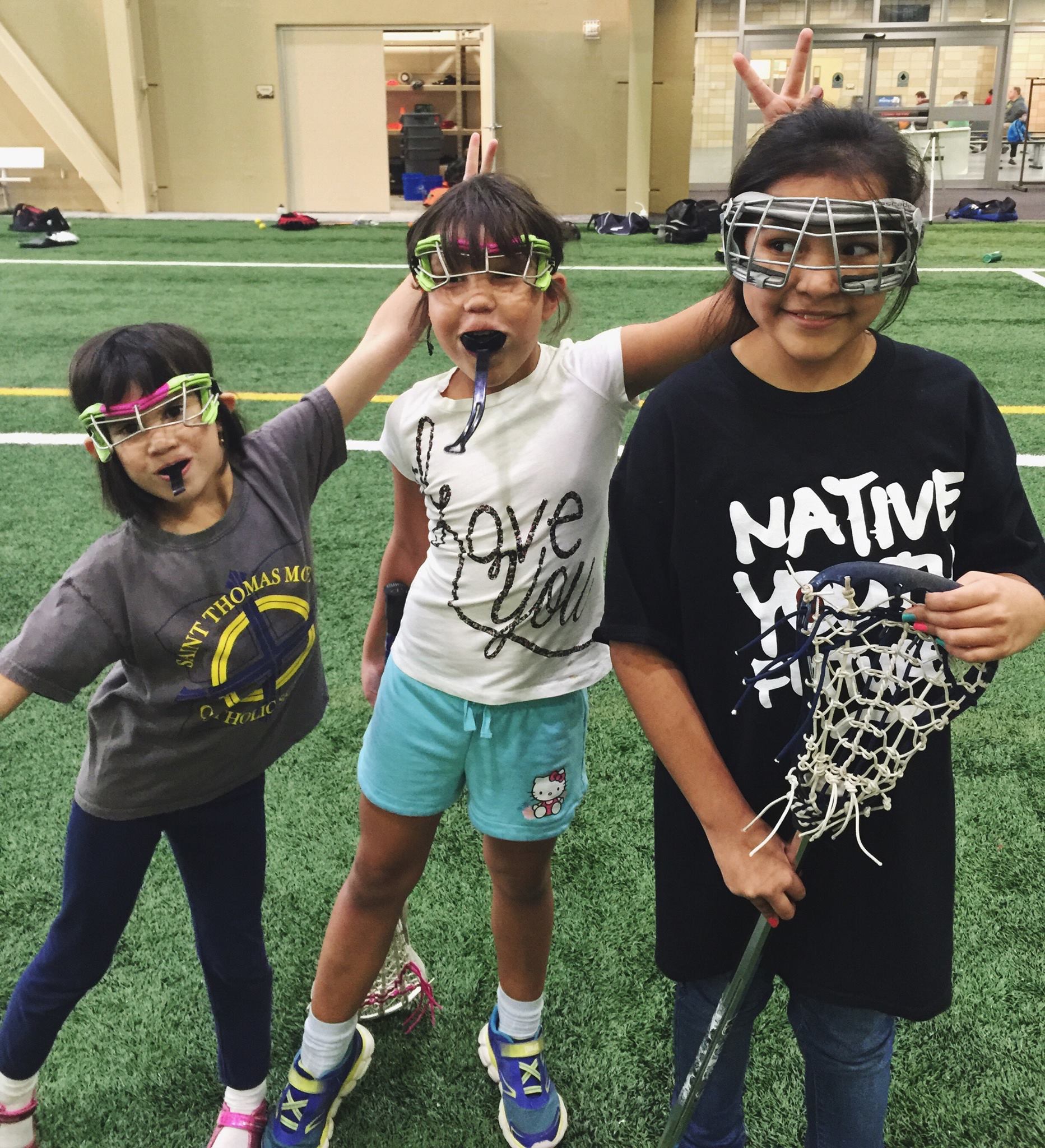
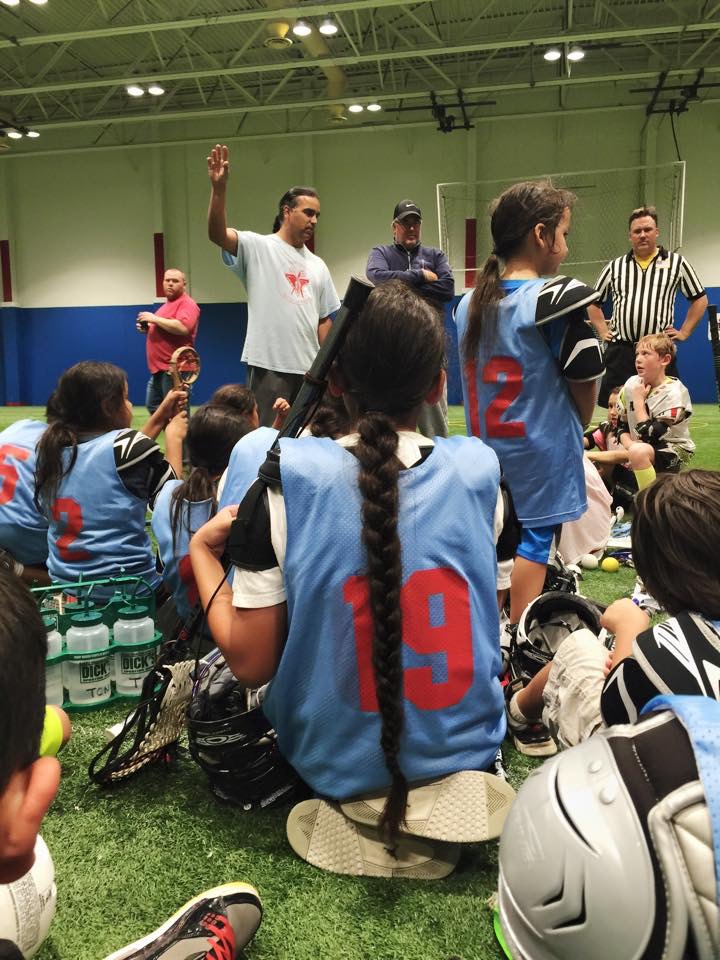
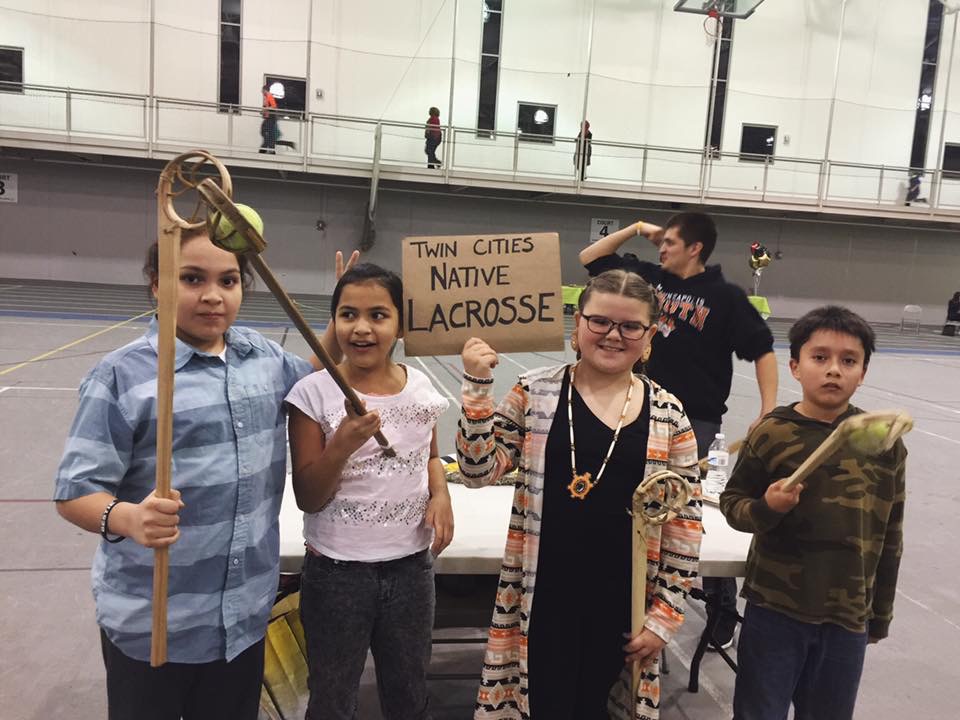



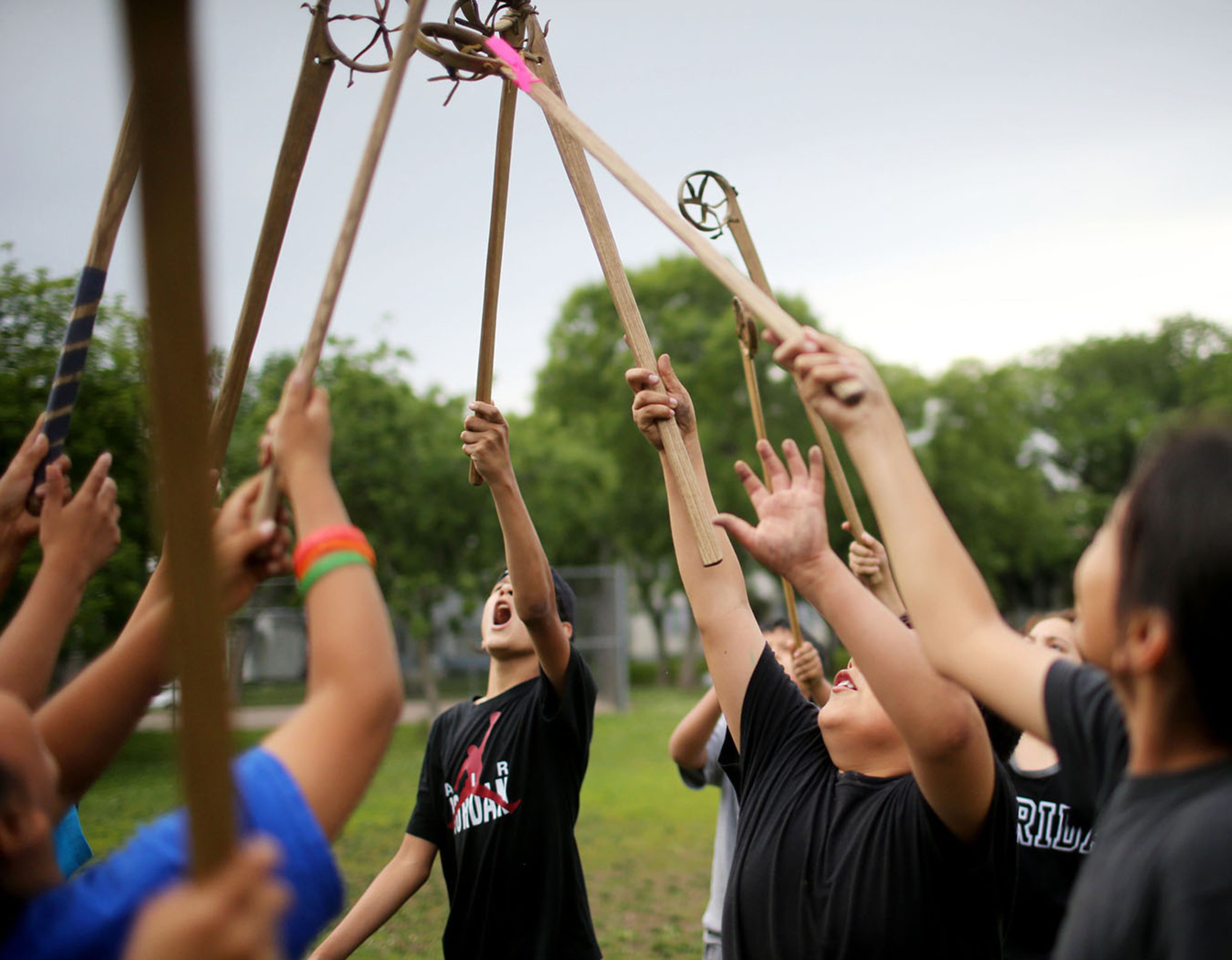


Simplify Your Approach to Fitness
Fitness today can seem complicated, to say the least. For many, the idea of working out has moved far beyond a recreational gym session and turned into its own science, its own language, its own technology... its own world. Fitness has never been more sophisticated or engaging.
In some ways, this is a great thing. We should recognize the science behind improving our physical health and take it very seriously. But in other ways, this turn-up in technicality can turn people away from fitness by making it seem too intimidating or scary. In some cases, our ability to measure things like body mass index; our engagement in the social media fitness world; the availability of fitness technology in apps and wristbands; and the incessant marketing of supplements and weight loss schemes can lead to an over-emphasis on looks or numbers while causing us to lose sight of functionality, wellbeing and fun.
I elicited the expert advice of Jessica Barudin (Kwakwaka’wakw), a yoga therapist and founder of Indigenous wellness site CedarAndGold.ca; and Dion Begaye (Dine), a strength and conditioning coach, in order to break down both the good and the bad elements of this technical side of fitness, and talk about how we can approach exercise with a healthy balance in both mind and intention. Here’s what it comes down to:
Be Wary of Appearance-Based Goals
There’s no question that a lot of people’s primary motivation behind fitness training has to do with looks.
“I hear it all the time,” said Dion, “people come in requesting slimmer arms or a thigh gap.”
The idea seems problematic. Shouldn’t we be focusing on how healthy we are, not how we look in the mirror? Ideally, that would be the case, but we have to be honest. We’re human, living in a very superficial world, and we want to feel good about ourselves. There’s a lot of pressure to look a certain way. Let’s try not to blame or judge one another for succumbing to those pressures.
“We all want that,” Dion admitted, “It’s okay to want to have a great body, but at the same time, what good is low body fat if your body can’t functionally move well?”
Jessica also notes the prevalence of appearance-based goals, and while she recognizes the problematic nature, both trainers agree that it’s not always a bad thing.
“People have their goals, and a lot of their own insecurities,” Jessica explained, “If somebody’s desire is to look physically better and that’s something they can commit to, that’s okay.”
The bottom line is this: if looks are what’s motivating you to get to the gym, and if that’s the only thing that can get you to commit to working out, it’s better than nothing. However, it’s important not to get too caught up in all of that. We are all born with unique body types and physiques. Some of us are practically born with a six pack, even if we eat burgers all day. Others will have a tiny back side no matter how many heavy weights we lift. If you are thinking too much about looks, you might be putting too much undue pressure on yourself and losing sight of the really important part of fitness, which has to do with health.
A fit body means that your organs, muscles, and joints are functioning well on the inside, and that’s always more important than how you look on the outside. A fit body means that you can run around, take care of your kids, make it up the stairs without collapsing. A fit body means that you can work, live, play, and do things for yourself and for your family. That’s always more important than looks - try to make that your priority, and you will become more fulfilled on your fitness journey.
Take the Numbers Out of Fitness
How many pounds can you bench? How much do you weigh? How many inches around are your thighs? What’s your body fat percentage? How many calories did you burn according to your Fitbit tracker? How many push-ups can you do?
Numbers, numbers, numbers. We get way too caught up in this and it’s exhausting just to think about.
While it’s important to measure some numbers from time to time, but be careful.
Good measurements to take for your health include monitoring your weight, cholesterol, blood pressure, and glucose levels at the doctor’s office. This type of thing can be done once a year (maybe more often if you are diabetic or have other illnesses), and should be taken into consideration while consulting with a professional to create a fitness and nutrition plan to improve your health.
However, do not get caught up in the day-to-day obsession with losing pounds or inches. Don’t count calories. Don’t worry about the difference between benching five or ten more pounds. Beware of these ego-driven goals, and recognize that those numbers don’t actually matter when it comes to how you feel and perform.
“If you can train your body to be more functional and serve its purpose,” Dion said, “you’ll live a better, longer, healthier and happier life.”
Here’s a suggestion: during your next workout, try not to focus on any numbers at all. Don’t time yourself, don’t pay attention to pounds, don’t watch the clock, and don’t weigh yourself. Just do some challenging exercises until you’re really sweaty and tired, then call it a day. You’ll feel just as good about your workout - maybe better.
There is some value in keeping track of things sometimes, especially if you’re an athlete training toward a certain purpose, but you should also prove to yourself that you don’t need any of those tools to give yourself a good workout. Think about what our ancestors did, how they stayed in shape. They just worked hard and made sure they were healthy enough to do their jobs and take care of others. That’s what we should focus on today, too.
Functional Fitness and Meaningful Movement
“Functional fitness” has become a buzzword in the mainstream strength and conditioning world, but we urge you to keep in mind that the idea of functionality in the indigenous world is a little different.
“Functional fitness is action-oriented,” explained Jessica, “It’s all about getting through our day-to-day lives. We can be more connected to things that are physically demanding, like helping out a neighbor, or being really active with your kids.”
She continues, “Think about movement that’s meaningful. Powwow dancing is a good example. You have to be so agile and light on your feet, you have to be so strong and have a lot of endurance. You can find meaningful movement in yoga, running, or many other activities too.”
So that’s what it all comes down to. Aside from all the science, the technology, and the elevated knowledge that comes with the fitness world today, we have to remember the root of it all. Finding movement that’s meaningful to you can lead to a healthier mind. Being a strong individual leads to being a strong and contributing member of your community. Functional fitness is a means of taking care of your family.
Dion sums it up like this:
“Train your entire body to function well. Train to eliminate muscular imbalances. Train to increase range of motion and mobility. Train to increase stability. Train to build muscle. Do anything that will increase your body’s natural ability to move.”
Don't call it "Paleo"
To be Well For Culture means to eat ancestral foods — foods that our ancestors have been eating for hundreds of generations and that continue to remain central to our indigenous cultures. Because an ancestral diet is often high in protein and healthy animal fats, low in carbohydrates, and markedly different from the common American palate of today, we get this question a lot:
"So ... ancestral diet is a lot like Paleo, right?"
This is a fair assumption, but the answer is:
"Not really!"
We take issue with a lot of the concepts and ideas behind the paleo diet, and we find it important to emphasize that ancestral diet is NOT the same thing. Here are some of the problems with paleo:
1. Paleo is a term that comes from Western science and practices. It is not an indigenous concept or idea. Paleo refers to the paleolithic era, which is a period of time in which "neanderthals" or cave-people existed. Non-Natives hold their "cavepeople" ancestors on a pedestal and emulate their dietary habits from this era because it is the closest connection they can find to a period in which their people ate in this healthier way. But, we as Native people know very well that our people have been eating in our own healthy way for thousands of years, including recent history and today. Non-Natives could probably learn a lot from Indigenous diets and observe that they are similar to their "paleo" concepts yet actually more well-rounded and healthy. However, they insist on de-legitimizing or ignoring Indigenous culture and would rather promote Paleo because this allows them to connect the original source of these ideas and life-ways with their own European heritage. Ultimately, we should not use the term "paleo" because it is a concept originated in western science and has nothing to do with Native people or culture.
2. Paleo diet is limited and restrictive. If you look up books or sources on how to eat paleo, you will see that they are very strict regarding what you can and cannot eat. Some of the items on their list for "okay" foods include things like bacon, chicken, and other stuff that our ancestors never ate. Other things on their "not okay" list include things like beans, wild rice, and other foods that are not only "okay" but that are critically important to the livelihood of our indigenous cultures and bodies. In an ancestral diet, it is acknowledged that a one-size-fits-all approach never works. Not only are ancestral foods different from tribal nation to tribal nation, but each person as an individual — no matter what your ethnicity or heritage — operates and functions differently. It's important to pay attention to your body and eat what is good for you. The paleo diet is far too specific and restrictive, and it is simply dangerous and unwise to prescribe the same foods to all people.
3. Paleolithic era promotes a linear concept of time as opposed to a circular notion of time. In indigenous cultures, we acknowledge that time is circular, not linear. When we refer to "ancestral" foods and "original" ingredients, we do not mean foods that our ancestors used to eat (past tense). Instead, we refer to foods that our ancestors have been eating for generations, never stopped, and that our people continue to eat. We do not cut off the timeline at some arbitrary point. Paleo, on the other hand, refers to foods that European ancestors ate millions of years ago and stopped eating. Indigenous foods are central to our cultures and always have been, and so it is important that we acknowledge ancestral foods as a living and breathing concept, alive in the present as much as they were in the past. Native people do not come from a static culture, but paleo foods represent a relic of the past — a figment in the imagination of non-Natives and a disconnectedness from their past to present.
4. Paleo fails to foster a holistic understanding of Indigenous food, culture, economics, and ceremony. In the paleo diet, there is little to no emphasis placed on the processes surrounding food harvesting/gathering/seed-saving/hunting, the spirituality of food, or the significance of food to culture and ceremony. Ancestral foods, on the other hand, are and have always been central to indigenous cultures, and the processes by which these foods are gathered and harvested and the significance that they play in our economies and cultures cannot be underestimated. In order to follow a paleo diet, it is okay to just go to the grocery store, spend a lot of money on products that are marketed as "primal" or "caveman," and go about your day. Ancestral foods or indigenous foods, on the other hand, are much more connected to land, culture and ceremony in significant ways that vary from nation to nation. From whale hunting in the far north to agriculture in the southwest (the list goes on and on), indigenous foods mean far more than grocery shopping and crossfit fuel.
Final Thoughts:
Nutritionists agree that the Paleo diet gets one thing right: they encourage cutting down on processed foods and adjusting the ratio of nutrients to increase fats/proteins and decrease sugars. It is an improvement from the average American diet, thus we are not judging or blaming anybody who has tried out a paleo model. However, as Indigenous people it is important and should be empowering to know that a better model for you is eating in line with what your ancestors used to eat, have always been eating and continue to eat today. Why eat what white cavepeople ate when foods from your own culture are more holistically healthy and right under your nose? Ancestral foods are nutritious, culturally significant, and surely the best option for indigenous minds, bodies, and wellbeing.
Read more at http://indiancountrytodaymedianetwork.com/2015/10/14/well-culture-why-natives-shouldnt-go-paleo-162076
Elder Fitness! Chair Yoga Poses for Everybody
“When we focus our energies internally we discover our strength to heal ourselves. Our ancestors lived in a way of balance, in the Navajo culture this is Hozho. “Hozho” is a Navajo belief, shared by other Indigenous beliefs, of a natural balance in the Universe of all things. It is each person's right and responsibility to create a balance in life so that we can contribute to our communities and build stronger families. When we learn how to cope with the stresses of life this helps us to make healthy choices for ourselves.” - Christine Means
You don’t have to be the most limber person in the world to try a yoga pose. In fact, yoga can be modified to suit those with very limited mobility or muscular conditioning. We love our elders in Native country, and that’s why we love what Christine Means is doing with Elder Chair Yoga.
Christine Means (Arikara, Yankton, Dakota, Navajo) is a 200-hour Registered Yoga Teacher (RYT). She teaches yoga to elders throughout tribes in the Southwest as well as other fitness classes to a variety of age groups.
Here’s what she has to say about the benefits of yoga practice:
“When we focus our energies internally we discover our strength to heal ourselves. Our ancestors lived in a way of balance, in the Navajo culture this is Hozho. “Hozho” is a Navajo belief, shared by other Indigenous beliefs, of a natural balance in the Universe of all things. It is each person's right and responsibility to create a balance in life so that we can contribute to our communities and build stronger families. When we learn how to cope with the stresses of life this helps us to make healthy choices for ourselves.”
Now that you understand the benefits of yoga for all, give it a shot! The following are instructions and guidelines for yoga poses that anybody can do. Don’t forget to invite your elders!
What You Need:
A sturdy chair that will not slip.
Comfortable clothes.
1. Breathing, Breathe, Breath
Sit up tall in your chair by reaching the crown of your head upward so that you feel yourself grow taller. Relax your shoulders down away from your ears. Place your hands on top of your thighs with your palms facing upward. Place your feet firmly on the ground. Your feet and knees should be hip width distance apart. Start to breathe in and out of your nose. As you go, make each inhale a little louder and each exhale a little slower. Take 5 breaths (in and out equals 1) focusing on expanding your lungs. Try to envision sending your breath to different places in your body. Focus on sending the breath to your toes, then inhaling up to the back of your neck, then exhaling down to your lower belly, then inhaling up to your heart. When you connect your mind to your breathing you can feel the energy you create and send that energy to the tight spaces in your body and mind. Throughout your yoga practice keep this focus on your breath going.
What it does:
Breathing techniques involve consciously regulating airflow through the body. When we breathe through the nasal sinuses, air passes through the pharynx into the trachea on to the lungs, oxygenating the blood. Focused breathing is an excellent method for bringing calm to your mind and your body. It allows you to focus on the moment while getting oxygen to the body.
2. Figure 8 Roll Out
Bring your hands together by interlacing your fingers with your palms facing towards your face. Extend your clasped hands out in front of your chest. Drop your chin down, bringing your eye gaze down to the floor. Reach your hands out in front of you slowly starting to roll your upper body in a figure 8 motion. Stop in the middle. Roll your body in the opposite direction. Keep your eye gaze down so that your relax the back of your neck and shoulders. If your shoulders are tight this will feel really good. Whose shoulders do not feel tight?! Take it slow and try to use your spine to help you move.
What it does:
Increases your spinal flexibility and range of motion. Helps to expand your shoulders and chest. Relieves lower, mid and upper back tensions. Strengthens your abdominal muscles.
3. Chair Pose
Sitting back in your chair inhale your hands up over head. Turn your hands so that your palms face each other and space your hands as wide apart as you need to. You can also try “cactus arms” by bending the elbows and keeping the palms facing forward. Extend your arms as straight as you can. Bring your eye gaze up towards your thumbs. Breathe in and out your nose here. Reach your finger tips up. Relax your shoulders down away from your ears.
Sitting back in your chair. Grab your thumbs together (see pic). Extend your fingers, hands and arms out in front of your chest. Inhale your hands up over head. Bring your eye gaze up to your thumbs. Take 5 breaths holding here. Keep your thumbs connected. Fold forward at your waist. Reach your fingertips forward in front of you. Bring your eye gaze to the floor. Take 5 breaths holding here.
What it does:
Lengthens through your entire spine. Stretches your shoulders and chest. Tones your back and arm muscles. Relieves tension and shoulder stiffness. Stimulates abdominal organs, blood circulation and heart.
4. Chair Pose Twist
From your seated chair position bring your ankles and knees together. Press your feet firmly into the floor. Press your palms together at the center of your chest. Take your right elbow across to your left thigh or to the outside of your knee. Keep pressing your palms together, bring your eye gaze to your thumbs. Breathe here 5 times. With each exhale try to twist a little further. Return to your start seated position. Take your left elbow across to your right thigh or to the outside of your knee. Press your palms together, lift through your chest, eye gaze to your thumbs. Breathe here for 5 breaths trying to twist a little further with each exhale.
What it does:
Spinal twists help relieve tension in the back. They help stretch the spine and can open up your shoulders, neck and hips.
5. Eagle Arm
Bring your right arm underneath the left, crossing the arms at the elbows and wrists. Press the forearms together. Keep the shoulders relaxed and lift the elbows. Switch the arm position. Bring the left arm underneath the right.
What it does:
Eagle arm gets deep into the shoulder muscles, the back of the neck and the whole arm. Improves range of motion in your upper body and arms.
6. Warrior 2
From seated position widen your stance by placing your right foot out at the side of your chair (your legs will be in a “L” shape). Your knees should be directly over your ankles. Press both feet firmly down. Bring your arms up and straighten them out, reaching your fingers in opposite directions, coming into a T shape with your upper body. Your eye gaze comes to your right fingers. Breathe here 5 times. Switch positions to the left side. Place your left foot out at the side of your chair. Press both feet firmly down to the floor. Bring your arms up and straighten them out, reach your fingers in opposite directions, open up across the chest. Your eye gaze comes to your left fingers.Take 5 breaths.
What it does:
Warrior 2 creates core stability, strengthens the legs and arms, aligns the spine, stimulates internal organs, and stretches the groins, shoulders, chest and lungs.
How to Shop Smart at the Grocery Store
Since we have to go to the grocery store, we have to learn how to shop smart. It’s actually pretty easy because the way that these places are organized makes it convenient to navigate around the unhealthy stuff. Here’s some tips for getting around, finding what you *really* need, and avoiding all the bad stuff.
Remember that every time you eat or drink something, you are either feeding or fighting a disease. Choose wisely.
To be “Well For Culture” means to maintain a healthy body and mind so that you can contribute to the wellbeing of your family, the future of our nations, and the sustainability of our cultural practices. It would be totally ideal if all of us could eat only natural foods that come from local or community sources all the time: hunting, fishing, gathering, and growing. But, at this point in time, the reality is that for most of us, a lifestyle entirely devoid of the grocery store is not in the cards.
Since we have to go to the grocery store, we have to learn how to shop smart. It’s actually pretty easy because the way that these places are organized makes it convenient to navigate around the unhealthy stuff. Here’s some tips for getting around, finding what you *really* need, and avoiding all the bad stuff.
1. Stay on the outer perimeter of the store.
Think about it: on the edge of the grocery store is where you find all of the produce, meat, and fresh foods. This is all you need. Stay out of the aisles! It’s all junk food packed with preservatives in there.
2. Avoid anything with a long shelf life or without an expiration date.
Again - stay out of the aisles. Our bodies are not made to process preservatives, so it’s best to avoid ingesting them. If it seems weird that certain foods can last for years and years without going bad, it is. That means they’re bad to begin with.
3. Avoid foods with more than 4 ingredients or with ingredients you can’t recognize or pronounce.
You should always know exactly what you’re eating. Can’t picture what “sodium ascorbate” or “butylated hydroxytoluene” really looks or tastes like? That means it’s probably not safe to eat. Chances are, if a food product contains more than 4 ingredients, something unnatural and unhealthy is involved. As a rule of thumb, stick to real food that doesn’t even necessarily need a label to explain what it is.
4. Avoid frozen foods or anything in cans, boxes, or bags.
You never know what goes into packaged foods. Frozen foods, for example, are full of sodium, so they lack the enzymes that your body needs to breakdown and digest. Even when they’re marketed as healthy, they’re not. As for anything else in a box, bag, or can, the preservatives themselves are bad enough, but there can be even more unpleasant things hidden in these products.
Imagine you’re in the produce section and you pick up a basket of mushrooms. What are the ingredients in the mushrooms? Well, duh, just mushrooms. Good. Now go to the aisle and pick up a can of mushrooms. What’s in it? It might just say “mushrooms,” but we know better. The plastic lining of the can, for one, contains BPA - a harmful chemical that can cause heart attacks and cancer. Open that can and you’re also likely to ingest some unexpected treats that won’t be listed: the FDA allows for up to 74 mites and 19 maggots for every 3.5 ounce can of mushrooms. Yeah, I’d go with the fresh one instead.
5. In terms of money, think about long term health.
By far the toughest thing about healthy shopping is forking over the cash for the healthier versions of everything. Healthy isn’t always more expensive, but it sure can be. (Again, this is why it would be ideal if we all just grew our own food). With that in mind, we urge you to shop healthy anyway, and try to think in terms of long-term savings. The bottom line is that bad food makes you sick and causes long-term illnesses. On the other hand, healthy food keeps you healthy! The more you prioritize your health and spend on better food, the less likely it is that you will be spending money on medical bills or pharmaceuticals in the future.
A final note: Remember that every time you eat or drink something, you are either feeding or fighting a disease. Choose wisely.
Which Mocs Should You Rock? The Ultimate Shoe Guide
The shoes you choose for working out can make a big difference! Not because of fashion or the way they look (though that’s fun too) - but because of functionality. The wrong shoes could impact your performance or leave you injured - but the right shoes could actually help you out.
There are a million different types of sneakers out there and a million different types of workouts, so it can be hard to know which ones to buy. Here’s a look at the pros and cons of different types of shoes, examples of each, and some guidelines for picking the right kicks.
BARE FEET, SOFT SOLE, MINIMAL SUPPORT, NO TRACTION
My example: My beautiful plains-style moccasins handmade by my beautiful and talented mom.
Other examples: Nike Studio Wraps; Ballet slippers; Other styles of moccasins; or basically anything else with very minimal or no coverage.
Best for: Dancing (of course) but also pretty much any type of studio workout like yoga; pilates; barre; light weight training that doesn’t require a grip or traction to the floor; and walking or hiking around rural environments like the plains where you can avoid stepping on cacti or sharp rocks. Shoes like these are great because they are flexible and comfortable. They’re pretty much the most natural-feeling footwear available and they keep you close to the earth.
Not good for: Walking around a city. You can actually contract disgusting infectious diseases by exposing your feet to the bacteria that is abundant in urban environments. Our ancestors wore these shoes or often went barefoot because they didn’t have to worry about the same type of germs that exist today. So, keep that in mind. These shoes are also not good for super rugged terrain - unless of course you have super rugged feet and you’ve conditioned them to be comfortable on extremely rough surfaces. In that case, be my guest!
LOW SOLE, MINIMAL SUPPORT, SLIGHT/MEDIUM or HEAVY TRACTION
My example: Nike Free 1.0 Cross Bionic (my absolute favorite training sneaker of all time!)
Other examples: New Balance Minimus; Converse All Stars; Vibrams; or any other “minimal” shoe.
Best For: Functional fitness and weight training. Any fitness coach will tell you that it’s important for your feet to stay flat on the ground while lifting. DO NOT wear thick-soled running shoes for lifting weights! They will totally screw up your alignment and leave you with potential back problems and awkward form. These thinner-soled shoes are also good for other things. The combination of flexibility, traction and natural movement with this type of shoe is the reason why, for me, it is my go-to, all-purpose sneaker for any type of functional fitness. If I had to choose just one pair of sneakers for the rest of my life, it would be these.
Not good for: Hiking, basketball, or other things that require ankle support.
LOW/MEDIUM SOLE, MEDIUM SUPPORT, MEDIUM TRACTION
My example: Nike Free 5.0
Other examples: Reebok CrossFit shoes; Nike Free 3.0 or 4.0; Adidas Speed Trainer
Best For: Cross training, running, functional fitness, weight training - pretty much everything listed in the previous section. There are a great transitional shoe: if you are used to wearing thick padding in your sneakers all the time but are trying to build muscle in your feet so that you’ll be comfortable in minimal shoes (which are ultimately better for you), try a pair like these in between.
Not good for: Even the light to medium level of support on these shoes can be too much when it comes to weight training or functional fitness. Too much padding can get in the way of the foot’s natural ability to move around. Just be mindful of that.
MEDIUM /THICK SOLE, LOTS OF CUSHION/SUPPORT, MEDIUM/HEAVY TRACTION
My example: Nike Air Max
Other examples: Basically all running and cross training sneakers with a thick sole and lots of padding, such as Brooks, Aasics, New Balance, Nike LunarGlides; and any other brand of running shoes designed with lots of support.
Best For: In my opinion, these shoes should pretty much only be worn casually or for walking around. They’re great for that, and can be super comfy!
Not good for: Running or cross training - even though that’s how they’re marketed! Dont’ believe the hype. Humans were not designed to walk around with a ton of padding on our feet, and we only started doing so in about the 1970s when the sneaker industry was revolutionized. Studies have shown, however, that rate of injuries among athletes who wear padded shoes has not decreased since pre-technology footwear. In fact, the prevalence of overly-cushioned shoes has increased rates of injury. When we wear clunky padding on our feet, our feet are not given the opportunity to develop muscle. Thus, they become weak. These types of shoes also contribute to high rates of poor running form. Humans were designed to run on our toes - not our heels. Proper running form is toe-heel, but because these shoes are so padded, they weigh down our feet and train us to run heel-toe. Not good! I would recommend transitioning out of these sneakers if you are currently using them. A little less cushion will be uncomfortable at first but will lead to a stronger foot and ankle with continued use.
A FEW MORE NOTES:
PRICE: Sneakers are expensive! Don’t feel like you need to own 20 pairs! The only time I would say that you really *need* to buy a new shoe is if yours are totally worn down. Also, even though I’m acknowledging that different shoes are good for different things, it is possible to find a really well-rounded shoe that suits most of your needs.
FOOT CONDITIONING & MUSCLE DEVELOPMENT: As I mentioned above, be aware of your own foot strength or weakness. If you have been wearing nothing but padded running shoes for years, don’t go cold-turkey and start doing marathons in moccasins. Transition slowly out of your clunky shoes as not to injure yourself. Just like anything else, it takes a little bit of time to build those muscles. But once they’re there, it’s so worth it!
SPORTS-SPECIFIC: There are a lot of different types of shoes that I didn’t mention here because they are specific to certain sports. For example: basketball, boxing, soccer, track, football… they all have their own type of shoe specifically designed for that sport. If your sport has its own type of shoe, use that where applicable.
EVERYBODY’S DIFFERENT: We all have different feet, different bodies, different medical needs. Test out different types and figure out what’s best for you. Be sure to really listen to your body and be patient when it comes to finding proper footwear. Also, keep this in mind: a lot of doctors are quick to recommend heavily padded footwear to correct pronation or for joint comfort. Remember that this is an outdated mentality and you shouldn’t necessarily listen to the first opinion. Consider everything I mentioned about muscular development and natural movement. If you haven’t yet, read the book “Born To Run” by Christopher McDougall. One day the magical perfect pair will come to you and you will live happily ever after as I am with my Nike Free Bionics!
Fitness Trends to Avoid... And What You Should Do Instead!
Find out which fitness trends to stay far away from... and of course, healthier alternatives to what these gimmicks are trying to sell you on.
In the fitness world, somebody is always trying to sell something. More often than not, it's a scam or a gimmick. We've seen a lot of troubling fitness trends surface recently, so here's a list of some of the most prevalent things that you should avoid at all costs. Remember: health over hype!
Waist Trainers
Why It’s Bad: Waist trainers are all over social media. Celebrities like Kim Kardashian and Jessica Alba are claiming that these contemporary corsets are the reason behind their hourglass figures. Don’t believe the hype! The truth is that waist trainers don’t really work at all. They only serve to temporarily cinch in your waist and make it appear that you have gotten thinner. But common sense should tell you that this, in no way, works to actually burn fat or make a lasting impact on your figure. In fact, this gut-squeezing device could actually cause harm to your body if worn over prolonged periods of time. Even in the short term, these things are uncomfortable. So, if you prefer to avoid symptoms like heartburn, shortness of breath, digestive issues, bone bruising, blood clots, or harm to your internal organs, I suggest avoiding this fad altogether.
What you can do instead: First of all, drop the mentality that a barbie doll figure is the ideal way to look: most women are not built that way, so don’t let these plastic celebrities lower your confidence. Feeling good is better than looking good, and that should be the primary goal with fitness. That said, if you are approaching fitness with a healthy mentality and happen to be particularly curious about burning fat around your waist, the number one way to do so is to eat well. A clean, ancestral diet full of healthy fats, original foods, and natural nutrients is the way to go. Drinking plenty of water also assists in leaning out. Don’t waste your time doing hours of ab exercises if your diet isn’t right in the first place. Do engage in daily exercise and eat good food in order to achieve a sustainably fit physique.
2. Crash Cleansing
Why It’s Bad: Fasting ceremonially or in times of prayer is, of course, a perfectly healthy and commendable sacrifice to make. It’s great to do that from time to time, and you know whether or not you’re doing it for the right reasons. What you should never do, however, is fast for weight loss or with hopes of getting thin. That would be starvation, and it doesn’t do your body or mind any good. Diets like the “master cleanse” and products like “skinny tea” are marketed toward those who are looking to lose weight quickly. What they really do is cause you to have diarrhea for a few days (not cute), drain all your energy, and severely dehydrate you. You might actually lose the weight, but as soon as you start eating even small amounts of food again, the pounds will pile back on. Rapid weight loss will slow your metabolism and yo-yo dieting could even lead to heart damage. Don’t do it!
What you can do instead: I’m not here to sell you anything so you can trust that I’m telling you the truth. The truth is that there is nothing you can do to lose weight fast in a healthy way. Why? Because “lose weight fast” is not a healthy mentality in the first place! If that’s your goal, it shows that you’re pursuing fitness for the wrong reasons. It’s great to set short term goals and to set out to improve your physical wellness, but you should always do so with this in mind: healthy living is a lifelong journey that should never be abandoned. There is no “end goal” - it’s just life. If you want to look and feel great, exercise regularly and eat a clean, ancestral diet.
3. Meal Replacement Shakes
Why It’s Bad: In the ‘90s it was Slim Fast. Now it’s HerbaLife. Sorry (not sorry) to those of you who peddle these products but they’re all a bunch of chemical-based garbage. Sure, they’re marketed with some enticing benefits: quick, tasty low-calorie beverages that will help you lose weight and won’t take a lot of preparation time. Sounds great, but the truth is that this stuff is hard on your body and your bank account. Meal replacement shakes are full of chemicals and strange ingredients, and it’s a problem if you don’t know exactly what it is that you’re putting into your body. Spend your money on something else.
What you can do instead: Get a blender; stock up on stuff like produce, coconut milk, and almond butter; and get in the habit of making all-organic, even tastier, even better-for-you, less-expensive smoothies and shakes. Sometimes, it is okay to get your meals in liquid form - as long as the ingredients come from the earth. Be sure to include enough calories and healthy fats to leave you feeling satisfied, not depleted.
4. Pre-Workout Supplements
Why it’s bad: Pre-workout is basically a combination of kool-aid and crack. Yikes! Okay, that’s an exaggeration but it’s really not good for you. People take pre-workout in an effort to boost their energy for a high-intensity training and weightlifting. While the surge of energy might seem enticing, it’s actually really unhealthy. In the short term, it can leave you feeling light headed, nauseous, dehydrated, and dizzy. In the long term, it can be addictive and dangerous. Pre-workout supplements contain so much caffeine and other types of artificial energy that they wear out your adrenal glands - the part of your body that gives you an adrenaline rush. So, if you take this stuff on a consistent basis, you’re ruining your body’s ability to produce natural energy. Also remember that it’s easy to build a tolerance to pre-workout. That’s the danger zone. Taking too much of this stuff can cause heart damage and kidney problems. Just stay away!
What you should do instead: Remember that the workout itself will give you energy, so just be patient and let your body do what it does! It only takes a couple minutes of warmup to get your heart rate pumping and your natural adrenaline going. If you’re feeling sluggish, it’s also okay to drink a small cup of black coffee before working out, or to eat an energizing snack like a handful of raw almonds. And of course, always stay hydrated. Water gives energy all the time. Just remember that pre-workout is a fad, it’s unsustainable, and it’s something that our people did just fine without for thousands of years.
A final word:
Remember that the FDA only regulates dietary supplements after they are already on the market - and only if a consumer makes a claim against them. The supplement industry is responsible for regulating itself, and so they often get away with huge discrepancies like telling you they’re selling you one thing when it’s actually totally different. They lie and get away with it all the time! So it’s best not to mess with these questionable corporate products at all, and rather to eat ancestral foods made from real ingredients. When you know exactly what you’re putting in your body, you are better off.
Reclaiming Ownership of Our Inherent Athletic Abilities
Welcome to Well For Culture.
In the Indigenous world, there is a beautiful and powerful movement taking place. It is a movement toward improved health, community wellness, spiritual health and mental strength.
Welcome to Well For Culture.
In the Indigenous world, there is a beautiful and powerful movement taking place. It is a movement toward improved health, community wellness, spiritual health and mental strength. We are witnessing the development of revolutionary Indigenized fitness concepts, and a return to ancestral foods. It is an exciting time.
Acknowledging that our communities have, in many ways, been largely unwell for a century or so, the youth from all nations are now doing something about it. This is potentially a watershed moment for the peoples of the tribes of the Americas. This is perhaps that moment the people will look back on and say, “that is when our communities healed.”
We see it in organizations like the Native Wellness Institute. We wear it on our sleeves via Nike N7. We post about it on Facebook pages like Healthy Active Natives. We hashtag it #indigefit on Instagram. Little by little, but at an increasingly rapid pace, our people are taking pride in and reclaiming ownership of our inherent athletic abilities and knack for harvesting, hunting and preparing natural, wholesome foods.
Families, individuals, networks and nations are coming together to support one another in living well.
Western civilization influenced us to build false yet alarmingly sturdy walls between formerly fluid components of healthy living. This led to the degradation of our healthy Indigenous minds. Our people are now tearing those walls down. Once again, we are drawing strength from our mental, physical, spiritual and emotional selves, fully understanding and remaining aware that ultimately, these facets of life are inseparable. Soon, we will forget about those walls. Our children will never know they existed.
Without realizing it, I joined this wellness movement several years ago when I became dedicated to fitness. Through these interests in Indigenous wellness, I connected with two people who have since become close friends: Martin Sensmeier and Thosh Collins. We came up with the name “Well For Culture” because we believe it describes the essence of the movement: being welland being about the cultureare one in the same. Well For Culture.
While we are working on several projects under the Well For Culture theme, the idea to write this column came about. You can now expect to see this column every Friday. Each week, I will feature new ideas, people, places, or events related to Indigenous health, fitness, athletics, foods, and everything else related to health and wellness.
With this introduction to my column, I’d like to offer an invitation. If you know about somebody or have heard about something going on related to Indigenous health and wellness, and you think I should write about it, I’d love to hear your ideas. Please feel free to e-mail or tweet at me. Join us in promoting an image of positive, strong, healthy Native people. Because that is who we really are.
Chelsey Luger is Anishinaabe and Lakota from North Dakota. She hopes to be a strong link in a long chain of ancestors and descendants by spreading ideas for health and wellness. Follow her on Twitter @CPLuger. Ideas for articles? Email her at wellforculture@gmail.com.





